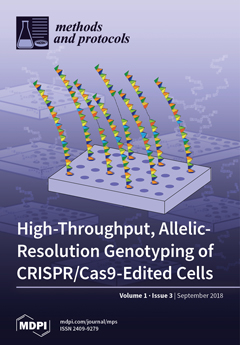Open AccessProtocol
Robust CRISPR/Cas9 Genome Editing of the HUDEP-2 Erythroid Precursor Line Using Plasmids and Single-Stranded Oligonucleotide Donors
by
Gemma Moir-Meyer, Pak Leng Cheong, Aude-Anais Olijnik, Jill Brown, Samantha Knight, Andrew King, Ryo Kurita, Yukio Nakamura, Richard J. Gibbons, Douglas R. Higgs, Veronica J. Buckle and Christian Babbs
Cited by 18 | Viewed by 8732
Abstract
The study of cellular processes and gene regulation in terminal erythroid development has been greatly facilitated by the generation of an immortalised erythroid cell line derived from Human Umbilical Derived Erythroid Precursors, termed HUDEP-2 cells. The ability to efficiently genome edit HUDEP-2 cells
[...] Read more.
The study of cellular processes and gene regulation in terminal erythroid development has been greatly facilitated by the generation of an immortalised erythroid cell line derived from Human Umbilical Derived Erythroid Precursors, termed HUDEP-2 cells. The ability to efficiently genome edit HUDEP-2 cells and make clonal lines hugely expands their utility as the insertion of clinically relevant mutations allows study of potentially every genetic disease affecting red blood cell development. Additionally, insertion of sequences encoding short protein tags such as Strep, FLAG and Myc permits study of protein behaviour in the normal and disease state. This approach is useful to augment the analysis of patient cells as large cell numbers are obtainable with the additional benefit that the need for specific antibodies may be circumvented. This approach is likely to lead to insights into disease mechanisms and provide reagents to allow drug discovery. HUDEP-2 cells provide a favourable alternative to the existing immortalised erythroleukemia lines as their karyotype is much less abnormal. These cells also provide sufficient material for a broad range of analyses as it is possible to generate in vitro-differentiated erythroblasts in numbers 4–7 fold higher than starting cell numbers within 9–12 days of culture. Here we describe an efficient, robust and reproducible plasmid-based methodology to introduce short (<20 bp) DNA sequences into the genome of HUDEP-2 cells using the clustered regularly interspaced short palindromic repeats (CRISPR)/CRISPR associated protein 9 Cas9 system combined with single-stranded oligodeoxynucleotide (ssODN) donors. This protocol produces genetically modified lines in ~30 days and could also be used to generate knock-out and knock-in mutations.
Full article
►▼
Show Figures






